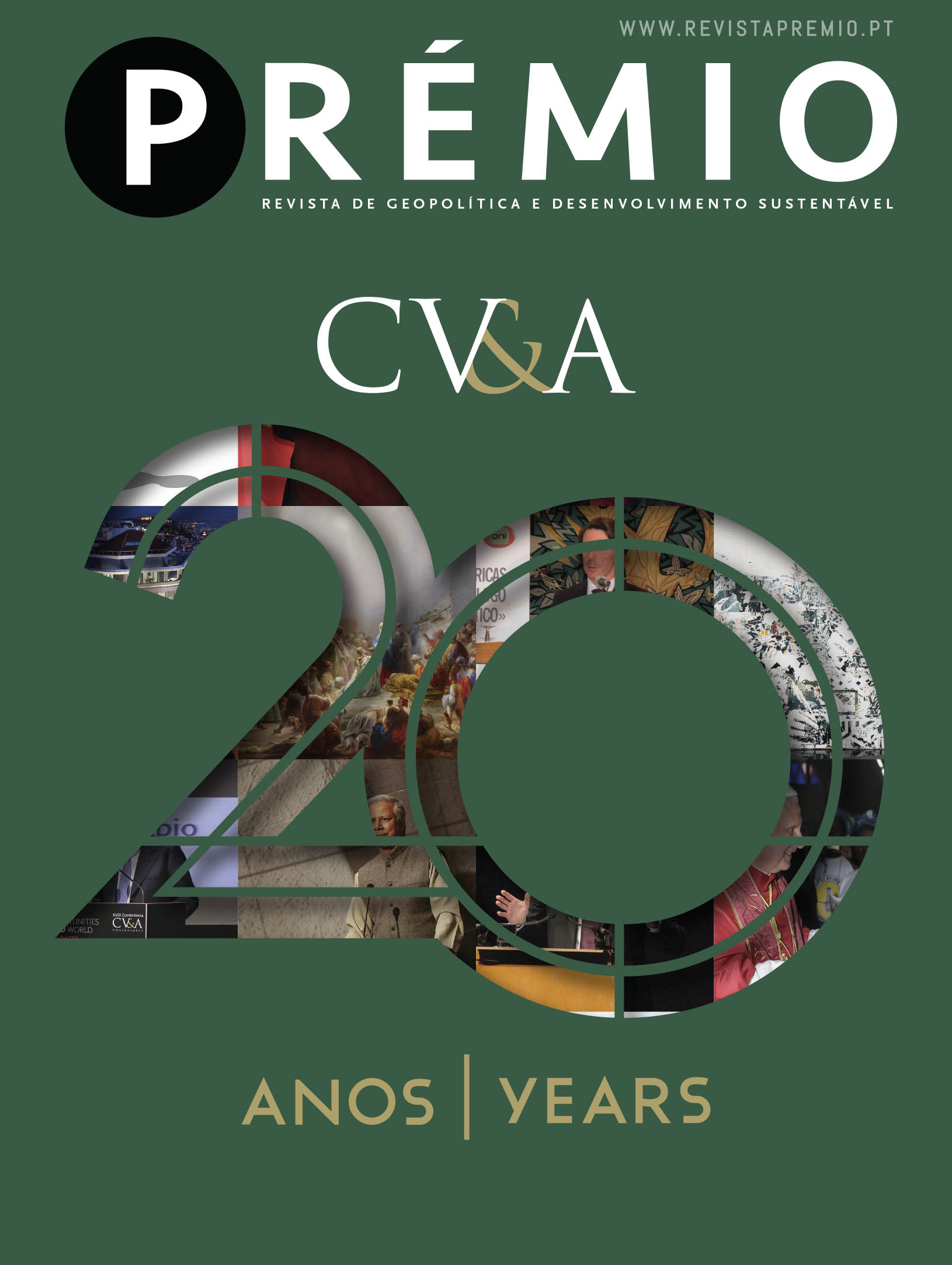Raúl Moreira, Philately Director of CTT
On November 6, 1520, King D. Manuel I signed in the city of Évora the royal letter appointing Luis Homem as the first postal officer in Portugal. Despite the existence of documents prior to that where the king’s private ambassador was already referred to as “postal officer” we formally date the beginning of the adventure of the public postal service in Portugal back to November 6 of that very same year of 1520.
But 500 years of postal service don’t mean 500 years of CTT.
The acronym CTT (Mail, Telegraph and Telephone) was first created in 1936 through Ordinance No. 8: 517 of August 28, 1936, enacted by the Minister of Transport and Communications, Joaquim José Andrade e Silva Abranches.
However, despite the changes in political regime, name, public or private ownership and the scope and reach of postal or telecommunications services no one can deny that the backbone of this activity has always rested on its workers and operational managers.
It was they who, over the centuries and following many structural changes ensured permanence of specific knowledge of postal operations, proximity to the Portuguese and the noble mission they were in charge of.
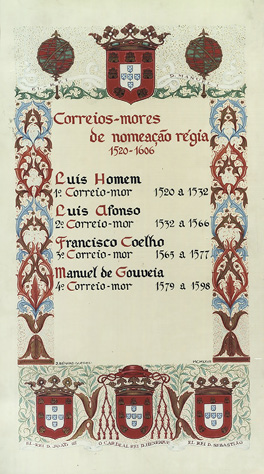
The mail officer of the kingdom was a postal service created by King D. Manuel I of Portugal on November 6, 1520, through Royal Letter which delivered the management of this service for the first time to Luis Homem.
Service and Collection
The value of proximity to citizens has always been a premise of CTT, as a company that distributes physical communications and considering the wide-ranging presence of Post Offices (today CTT Stores) throughout the country.
The CTT Service Network, composed of CTT stores and post offices, guarantees the existence of at least 1 postal establishment in each municipality in the national territory and so therefore 95% of the national population is located at a maximum distance of 6 km from each of these establishments. This Service Network shows the good level of penetration of postal services with a density of postal coverage in line with the Community average.
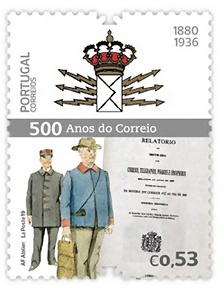
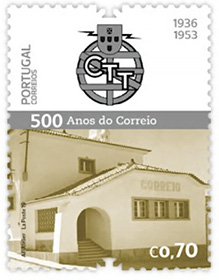
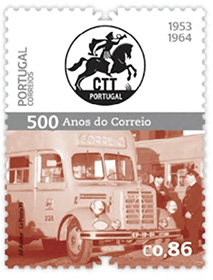
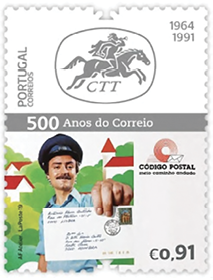
Stamps with historic logos of the company
Thus, it makes perfect sense for the current company CTT Correios de Portugal SA to consider itself a legitimate heir to the work of Luis Homem, in line with the work of both royal postal officers and postal superintendents of the Republics over these 5 centuries.
The same happened in Europe where the legacy of Baron Thurn und Taxis in Bavaria set the standard for the creation of public postal services. These historic Postal Operators are now rightfully celebrating or preparing the celebrations of the important anniversary of 500 years of postal services in their different countries.
If we had to choose only five essential milestones to tell this 5-centuries old Portuguese history these would probably be:
– Its inception, in 1520, through the royal letter by D. Manuel I
– The first privatisation of postal services in 1606, upon decision of D. Filipe II who handed over these services to the Gomes da Mata family.
– Reintegration into the State of postal services, by Queen D. Maria I, in 1798
– The creation of the Postal Code, a turning point towards modernity, in 1978
– The second privatisation of the postal services, in 2013, opening up ownership of the company CTT Correios de Portugal to public capital.
Banco CTT was the direct result and natural evolution of financial services already provided by CTT and shares 500 years of history and experience. It was launched on the market on March 18, 2016, with a proposal based on the values of trust, solidity, proximity, simplicity and innovation.
This represent our ongoing focus on provision and value-added financial services. And, together with the market for urgent mail and parcels, which has been witnessing continuous growth in Portugal and around the world, this is an important part of the company’s strategic development triangle.
Sustainable development, environmental friendly, focused on the Customer and based on the principles of non-discrimination of gender, race or religion.
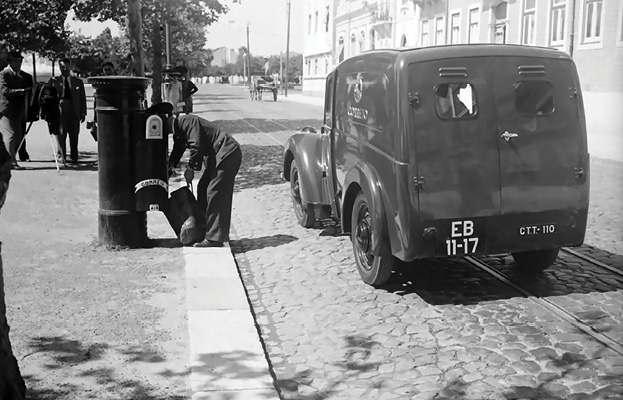
Mail collection in mailbox

International service at the Central Parcel Station
Sustainability and Corporate Social Responsibility
Innovation, technology and environmental sustainability are part of the genetic code of the CTT brand and are a priority for this company, heir to 500 years old activity.
Within the context of future challenges as regards sustainability “lato sensum”, proclaimed by the UN as a major goal of the 21st century, CTT gradually structured the sustainable intervention in the economic, governance, environmental and social spheres.
It is worth mentioning some highlights among so many accomplishments:
– Establishment of a table of sustainability objectives, applicable to the more than 12 thousand workers in the group, from the management to front office clerks and postmen;
– Implementation of a broad environmental agenda, supported by the themes of legal compliance, carbon management and climate change, energy efficiency, waste management, certified management systems, responsible procurement, training and awareness;
– Certification: more than 700 organizational units within CTT. It is by far the largest number of certifications for a single company at national level;
– Sustainable mobility: with more than 250 less polluting vehicles (two, three and four wheels), we operate the largest fleet of alternative vehicles in the country;
– Launch of an ecoportfolio: we are the only postal operator worldwide offering ecological services for companies and individuals (Green Mail and DM Eco);
– Publication of sustainability reports with the highest level of external scrutiny, presenting about 50 sustainable public goals;
– Creation of the CTT volunteer scholarship and active business patronage;
– Social solidarity: CTT’s Project to Fight Poverty and Social Exclusion, which has already promoted the free delivery of 15,000 parcels to 45 institutions and more than 500 tons of donations sent to the most deprived regions.
This performance in the area of sustainability received external recognition.
In 2010, CTT were considered world leaders in carbon proficiency in the postal sector in the “Value chain management and dissemination and reporting” categories, and ranked 1st in the National Climate Responsibility Index. In 2012 we won the “World Mail Awards” in the “Corporate Social Responsibility” category, the most prestigious in the sector.
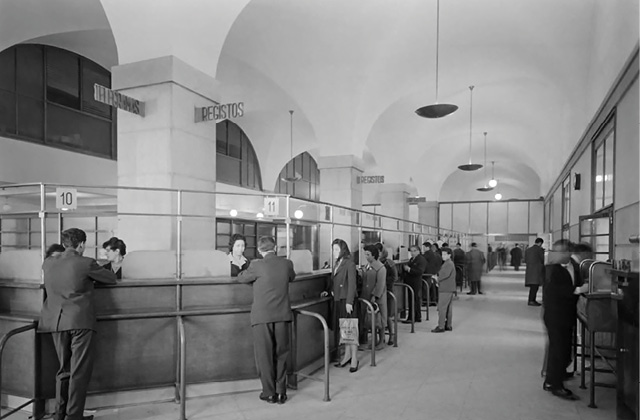
Terreiro do Paço Postal Station
Innovative Products for the Global Market
Innovative services in the Postal Activity, such as geoindex, mailmanager and ViaCTT are proof of CTT’s continuous investment in new technological solutions, resource improvement, better organisation and cost reduction.
Geoindex enables – through geographic perception and knowledge of the territory in which it operates, based on the organisation and handling of different sources of information, – the development of geomarketing studies that are fundamental for strategic decision making inherent to the management of companies.
Mailmanager manages the corporate mail, scanning, classifying, indexing and sending in digital format the physical mail received by the Customer. The collection of information in digital format related to invoices, returned mail, complaints, receipt notices and others allows the Customer to optimise the processes downstream of the receipt of mail.
And given that nowadays instant communication results from a process of natural evolution, CTT provides an electronic mail service, ViaCTT, allowing companies to reduce costs and enjoy a secure communication channel that is simultaneously a billing channel. The recipients of this mail (companies or individuals) have an electronic mailbox to receive, organise, make payments and file their mail in digital format, in a secure, confidential and free manner.
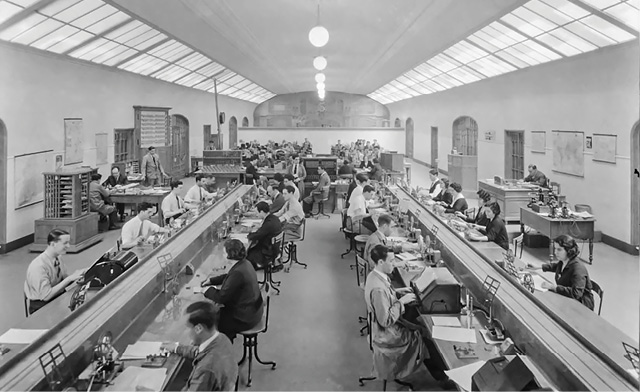
Telegraphic and Telex Service, 1940’s
With around 98 thousand customers/day in CTT stores and a daily average of one addressed postal item per household, accessibility is one of its distinguishing marks. The company offers the largest contact network at national level, acting as a pivotal element for the social cohesion of the national territory.
Following the new market trends and considering that the CTT Network is part of the “human face” that is company is to be granted, a new CTT Store concept was thus developed.
This new “Future Service Network” paradigm combines several convenience maximisation processes, providing a balance between personalized service and ‘self-service’ and allowing greater flexibility in service, time, easy access and communication factors.
Despite the very strong development of electronic communications in recent years, CTT continues to focus on proximity, through the network of postal establishments with 9657 points for the collection of physical communications – mailposts and mailboxes – in a vast network that covers the entire national territory in a structured manner, ensuring high ratios of density and proximity to the populations and maintaining at least one mailpost/mailbox per parish.
Even in the most remote places, where there are no grounds for the existence of a mailbox, the collection of mail can be done, by hand, by the postman who distributed the mail.
CTT guarantees the daily collection of mail deposited in the entire network in order to allow mail to be distributed to any address and following the respective service standards.
To this end, CTT has a dedicated collection network that mainly covers urban areas and mailposts and mailboxes with the highest traffic volume. The remaining mailboxes are collected when the postman distributes the mail.
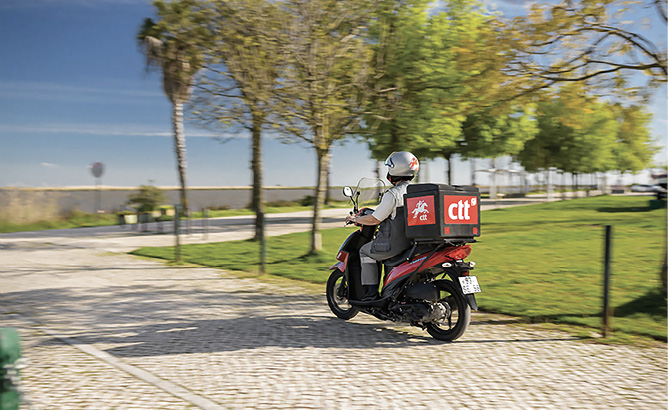
Bike courrier
Transportation
The need to exchange messages has always led to the search for all kinds of solutions to fight distance.
In the past they were squires, couriers on horseback, mounted couriers and the so-called railway “ambulances”. The slowness and uncertainty were enormous; the routes, now covered in a few hours, took more than a week to cover; international mail depended on ships and sea routes.
At present, CTT Correios de Portugal uses all kinds of modern means of transportation – lorries, airplanes, boats – integrating a National Transport Network structured around three levels (primary, secondary and tertiary network) and an International Transport Network and to / from the Autonomous Regions.
The National Postal Transport Network has been based entirely on road routes since the 1980s, and travels approximately 14 million kilometres annually and is continuously monitored to ensure high performance (compliance with timetables) and a real adjustment to the needs of traffic and necessary optimization.
The fleet used is about 350 vehicles, mostly lorries and is now undergoing a Consumption Rationalization Plan in order to ensure their reduction. An electric vehicle acquisition plan was also underway with a view to its frequent use at CTT and the first started operating in 2011.
International mail and mail to the Autonomous Regions of the Azores and Madeira are mostly transported by air.
The postal transport activity is fully covered by quality and environment management systems (ISO 9001, ISO 14001 standards and the extension to the OSHAS 18001 standard).
There is also a training plan under way within the scope of road accident prevention and driver retraining (ecological and defensive driving) thereby reducing the accident rates and reducing consumption.
Handling and Distribution
The postal handling has the mission of ensuring the processing of postal objects in order to guarantee quality standards, the application of standards in each work process and the maximization of the use of the equipment used.
The handling is thus in an intermediate position in the postal chain and offers an extremely positive contribution for the company to meet its objectives.
In order to better serve our millions of customers, wherever they are, a network of routing has been created in order to be able to reach the entire population as quickly as possible.
The routing network consists of 2 Production and Logistics Centres at the national level (Cabo Ruivo and Maia) and Logistics Centres scattered throughout the country to maximize the support provided to the existing Postal Distribution Centres.
In these Production and Logistics Centres, vehicle loading and unloading, sorting, preparation, manual division and automated division of mail activities take place and Logistics Centres work essentially as cross-docking platforms supplying the Postal Distribution Centres.
Automation of these activities and the respective operational processes, as well as their combination with the specific needs of certain customers, has become one of the main objectives in recent years. The existing machinery in these centres reflects the high investments made by CTT over the last few years with a view to improving automation levels, consisting of machines for segregation and obliteration, reading and indexing machines, machines for “fine” division, machines for “medium” division and more recently with an innovative bulk mail division, automated internal object transport systems and automated object location systems, Track and Trace.
Approximately 3 million objects are handled daily, of which more than 80% are automated, and almost 60% of these are shipped directly from the Production Centres to the respective distribution circuits throughout the country.
Likewise, the processes and activities supporting the operation are based on systems and technologies that allow them to be monitored in a close, frequent and rigorous manner, ensuring compliance with the defined service levels and providing information on the performance of the entire operational network.
Handling has been increasingly focusing on the quality of service, innovation and technological development. There has been also particular focus on reducing costs, increasing technical skills in terms of human resources and certification.
The many thousands of itineraries that our postmen travel every day early in the morning, even under adverse weather conditions and with the same dedication, for more than five centuries, are a fundamental contribution to ensure the safe and efficient transmission of messages between all our customers.

Head Office of CTT
This is postal distribution: ensuring that the last mile, the last task of postal operations, which consists of delivery to the recipient, is carried out in an effective and efficient manner; working to ensure the urgent need to establish bridges, to be where we are needed, face to face, close to the Customer and the business at all times.
In order to achieve this objective, there are thousands of postmen who travel around 246 thousand kilometres daily, using motor vehicles (vehicles and/or motorcycles), but also on foot in the main urban centres.
In line with our concerns as regards the “fragility” of the Earth, we have been adopting sustainable practices as regards travel. It was this concern, widely shared by all areas of CTT that has led us to encourage our postmen to use different types of electric vehicles (light vehicles, mopeds and even bicycles) to deliver objects which are increasingly being produced with environmentally friendly materials and processes.
Sustainable development, environmental friendly, focused on the Customer and based on the principles of non-discrimination of gender, race or religion.
Over the years we have built a proposal of both trust and proximity to the Portuguese. This centennial brand of ours has maintained a high profile of public recognition, becoming a symbol of notoriety, a positive image, confidence and an economic and financial value of remarkable relevance.
By innovating and renovating its offer CTT is today – and will always be – one of the preferred companies of all Portuguese.
In short, over the centuries we have built a proposal of trust and proximity to the Portuguese.
This centennial brand of ours has maintained a high profile of public recognition, becoming a symbol of notoriety, a positive image, confidence and an economic and financial value of remarkable relevance.
By innovating and renovating its offer CTT is today – and will always be – one of the preferred companies of all Portuguese.
We will continue to connect people and companies, delivering the most.


